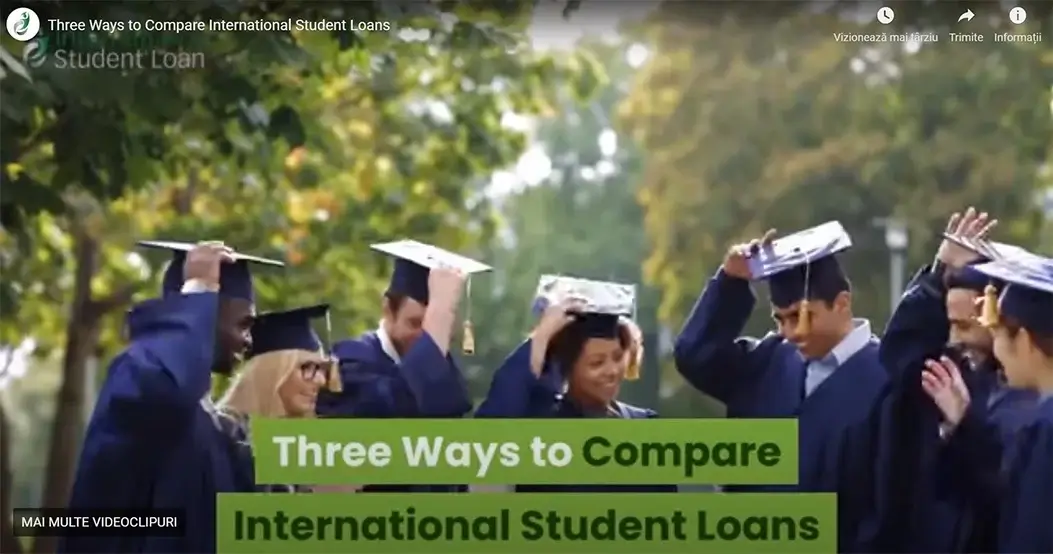
3 Ways to Compare International Student Loans
If you are a student considering going abroad, then you will most likely need some form of financial assistance to help cover your tuition. While there are many options for international students when it comes to scholarships and grants from the government or private organizations, not all these programs offer enough money for every student.
That's why many international students are often faced with the difficult decision of choosing a student loan. Understanding international student loans can be tricky because they differ from US-based loans in many ways, including interest rates and repayment plans.
The best way to find the best option for you is by comparing international student loans that have different conditions and repayment plans and selecting the international student loan that best meets your needs.
In this article we're going to cover the following points:
- interest rates
- repayment plans
- and loan terms.

You should seek advice before taking out any loans. You can get advice from your school's Financial Aid Office, International Student Advisors, Independent Financial Advisors, your parents and more.

1. Compare the interest rates
Different lenders will have different ranges of interest rates on their international student loans. Some might offer lower, more competitive interest rates, some may have higher rates but will accept applicants without such good credit history.
The interest rate you receive from a lender depends on several things like your credit score, the length of time you are taking to pay back the loan and your income.
When financing your education, you'll need to consider different types of interest. Some are fixed rate where the payments will stay the same for a period of time while others have variable rates that change over time.
A variable interest rate means that the interest rate can change over time based on certain factors. Variable interest rates can work out cheaper or more expensive in the long run depending on factors you cannot control. A fixed interest rate, however, does not change, so international students have more certainty of the cost of their student loan because monthly payments won't be affected by interest rate changes.

2. Compare the repayment plans
If you take out a loan, lenders will have different repayment terms. The most common are five year and ten year plans with fixed monthly payments.
With most lenders, you will make lower payments while you are still studying - and for up to 6 months after graduation. These reduced payments may cover interest and capital or may be interest only payments. In rare cases you may find a lender that allows you to delay repayments completely until after you graduate (in school deferment).
Remember that even though these reduced and flexible repayment options sound great, you will still have to repay all the money you owe. Lower initial payments may mean that you have to repay the loan over a longer period, ultimately costing you more money. While you are making interest only repayments, the amount you owe the lender is not going down.

3. Compare the loan terms
Different lenders have different terms and conditions for their loans. It's important to shop around to find the right lender based on your needs.
These may cover eligibility criteria, whether or not you need a cosigner or guarantor, minimum credit score, or whether there are any discounts available on repayment - such as signing up for automatic payments or maintaining good grades in school.
Your expected graduation date is also another factor that the lender will take into account when considering applications from non US citizens.
Other things you will want to consider
Cosigner
Only a small number of private student loan lenders will offer an international student loan program. And most private student loans require a cosigner – a U.S. citizen or permanent resident with good credit history – to join the loan application. In other countries a cosigner may be known as a co-applicant, co-borrower, sponsor or guarantor. The role of the cosigner is to assure the lender that they will repay the loans if you are unable to do so.
If you have a family member or close friend who is willing and able, it may be worth asking them for help. A cosigner can lower your interest rate if they have good credit history, which could save you money in the longterm.
If you don't have someone who can act as a cosigner who is a U.S. citizen or permanent resident, then your student loan options are reduced, but you can find "no cosigner loans" from some online lenders.
The amount you can borrow
With international student loans the maximum amount you can ever borrow is equivalent to the "total cost of attendance", minus any other financial aid received in the form of grants, awards, scholarships etc.
The total cost of attendance is a single sum that includes the following: Tuition, fees, books and supplies, room or board (or other living arrangements if not provided by school), local transportation costs including monthly bus pass; personal items such as laundry service or dishwasher detergent; miscellaneous costs for daily living at school that could include a printer cartridge, art supplies or photocopies; and other expenses such as those for a laptop computer.
In practice, though, the maximum loan amount international students can borrow is set by the lender. It may be up to $25,000 per year, or up to $50,000 over a 2-year period.
Institutional Financial Aid
Taking out a private student loan is a big decision. First explore all your alternatives. Many international students are able to receive funding directly from the school they are attending. Your school's financial aid office can advise you on the scholarships and awards that they have available, including any that are specifically for their international students. Any institutional financial aid received will reduce the total cost of attendance.
Federal Student Aid
Federal student loans have the most competitive interest rates, but are not usually available to international students. Federal Student Aid is only available to students with a social security number and are citizens or permanent residents of the United States.
Loans for international students are only available as personal loans from specialist private student loan companies. Many colleges require all students to fill out the FAFSA which is a form to apply for federal student aid.
Study Abroad Students
US Students studying abroad should first see if they are eligible for federal financial aid and federal student loans before considering private student loans.
If you are a student and your credit is not good enough to meet the minimum credit score required by the lender, then you can apply with a US cosigner. This will help you get a better loan offer and interest rate.
Timescale
It only takes a minute to use the comparison tool to compare loans and see if you qualify.
Applying with the loan provider online might take an hour or so.
If everything goes well, you would receive your initial approval (sometimes called conditional approval) within a week or 2.
At this point you would need to provide any further information that your lender requires in order to make a final decision.
Once fully approved, the funds are paid out directly to your school - known as disbursement.
From start to finish this process can take as little as 6 weeks, but may take longer, so you must plan ahead.
Availability
These student loans are available to international students studying in the U.S. and Canada. They are also available to U.S. citizens and permanent residents studying in Canada and around the world. Canadian students in Canada can also apply.
Unfortunately we currently do not have any private student loans for international students studying in other countries around the world, or in their home country. These international borrowers would need to find a local lender.
Graduate students and undergrads within 2 years of their graduation date can apply without a cosigner if a lender is available at their chosen school.
Student loans are available at eligible schools across the U.S., in Canada and at schools across the globe for U.S. citizen or permanent resident students.
Immediate Repayment
Failure to maintain your proper enrolment status in school may result in a loan default, resulting in the lender requiring the immediate repayment of your student loan. This may have an impact on your US cosigner, and their credit score, if you have one.

How to Apply for an
International Student Loan
The first step is to see whether you are eligible for an international student loan based on your circumstances. Just use the loan comparison tool on this page by answering a few simple questions about yourself and the school that you are attending.
Our international student loan comparison tool will then show you which lenders have student loan products that match and their interest rate range. You will then be guided to the student loan lenders sites where you can complete a loan application if you decide you want to go ahead.

The Best International Student Loans
Which is the best international student loan for you? This is going to depend on the specific private student loans that you are eligible for, and finding one that meets your needs. As the primary borrower can you get a loan without needing a US citizen or permanent resident to act as a cosigner? Can you get a loan that covers up to the total cost of attendance at your chosen school? Will you be able to afford the monthly payments? Does the financial institution offer interest rate discounts or interest only payments? Are you eligible for the most competitive interest rates? Are you within 2 years of your graduation date?
It's only after you ask yourself all of the questions above and compare the options you have available to you that you will be able to decide which is the best student loan for you and your situation.
Get the Financial Aid Newsletter!



